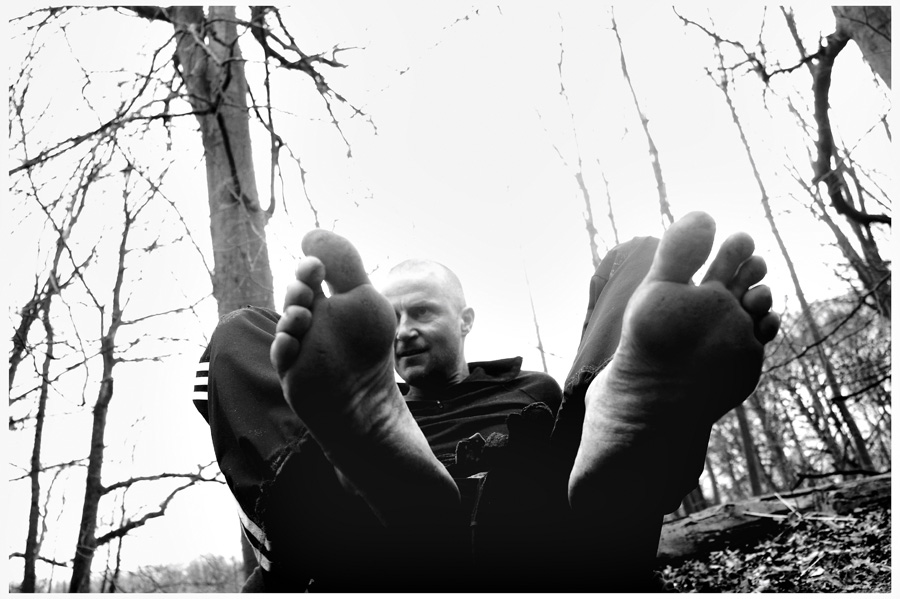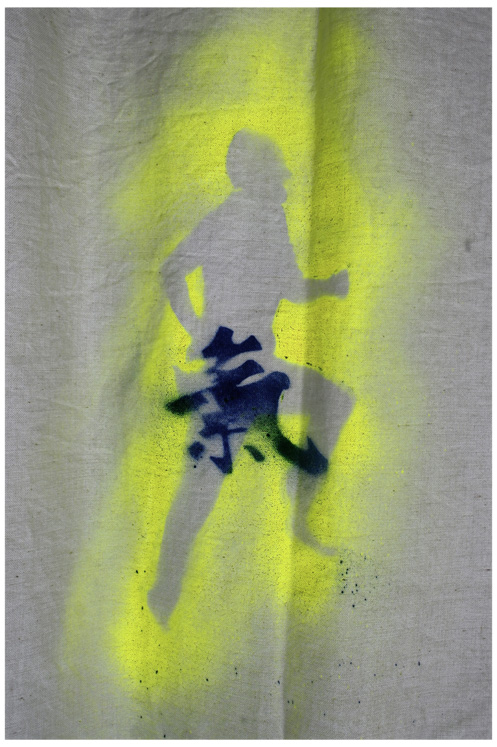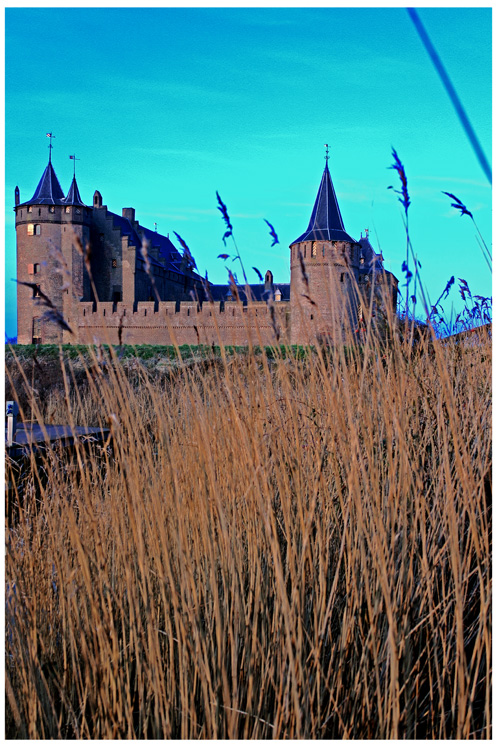Footprint_SAR_3
- Details
- Hits: 8382

Above: Footprint after deserted dune-/beach-scape SAR 3. Fresh day, some wind from the South/West, with silver sun reflections -- 30K. Meeting Peer -- master-carpenter and builder of the new, still located at the geographical center of the Dune/Beach-training-route, 'Beach Inn' place -- driving his Land Rover on the beach, is always fun -- we regularly run into each other. Our talk lasted about 20 minutes while several flocks of returning birds from the South flew over and two bulldozers shovelled excess sand back into sea, to make way for the return of the summer-beach-houses.
Todays training dedicated to [Land Rover owner] Bastiaan Houtkooper and his web-hosting company 'Zebra hosting'. In a (telecom-)world dominated by moguls and morons, Bastiaan founded, owns and operates a state of the art web-hosting company -- his costumer support and brilliance in trouble shooting is beyond comparison, rooted in deep empathy and years of experience as high-end cinematographer for commercials mainly.
Zebra hosting website: http://zebrahosting.nl/
Bastiaan Houtkooper's personal showreel website: http://bastiaanhoutkooper.com/
SAR_sarsential™_17_center_of_gravity
- Details
- Hits: 8329

Sarsential 17: Center of Gravtity [ Identity ]
"The creation of any modern nation state is characterised by the elaboration of an official history, a legendary narrative produced for purposes of unification, an ideological construct that glorifies a more or less imaginary ethnic group and encourages the rejection of any kind of otherness, regarded as inferior, indeed contemptible. Given that no-one escapes such cultural tensions [...] our intention is not to stigmatise these artefacts of identity, but rather to minimise them, in order to highlight the multicultural and multiconfessional profusion [...]"
French qānūn performer and conducter Julien Jalaleddin Weiss, in accompanying booklet to double CD recording of 'Ensemble Al Kindi Perfums Ottomans', first published in France by Zamzama Productions, Paris, 2006
"Carl von Clausewitz was a Prussian military theorist who thought of the center of gravity as a focal point, the one element within a combatant's entire structure or system that has the necessary centripetal force to hold that structure together: "The CoGs of Alexander the Great, Gustavus Adolphus, Charles XII of Sweden, and Frederick the Great, for instance, resided in their respective armies. In different circumstances, the personalities of key leaders, a state’s capital, or its network of allies and their community of interest might serve as CoGs. What all of these various elements have in common is not that they are sources of power, but that they perform a centripetal or centralizing function that holds power systems together and, in some cases, even gives them purpose and direction. Strictly speaking, an armed force is not a “source” of power. Rather, it serves as a focal point that draws and organizes power from a variety of sources: a population base (recruits); an industrial base (weapons and materiel); and an agricultural base (foodstuffs). The same holds true for the personalities of key leaders, state capitals, or alliance networks. These things draw raw power from different sources and refine, organize, and redirect it."
Read and download 'Clausewitz's Center of Gravity' on the Strategic Studies Institute website: http://www.strategicstudiesinstitute.army.mil/Pubs/display.cfm?pubID=363
Ensemble Al Kindi website: http://www.alkindi.org/
Link to original post with 3 pictures: http://bartvanbroekhoven.com/en-US/running/41-muiderslot
Muiderslot
- Details
- Hits: 8094

Above: Muiden, Januari 12th 2013
Carl von Clausewitz was a Prussian military theorist who thought of the center of gravity as a focal point, the one element within a combatant's entire structure or system that has the necessary centripetal force to hold that structure together: "The CoGs of Alexander the Great, Gustavus Adolphus, Charles XII of Sweden, and Frederick the Great, for instance, resided in their respective armies. In different circumstances, the personalities of key leaders, a state’s capital, or its network of allies and their community of interest might serve as CoGs. What all of these various elements have in common is not that they are sources of power, but that they perform a centripetal or centralizing function that holds power systems together and, in some cases, even gives them purpose and direction. Strictly speaking, an armed force is not a “source” of power. Rather, it serves as a focal point that draws and organizes power from a variety of sources: a population base (recruits); an industrial base (weapons and materiel); and an agricultural base (foodstuffs). The same holds true for the personalities of key leaders, state capitals, or alliance networks. These things draw raw power from different sources and refine, organize, and redirect it." Download and read interesting paper 'Clausewitz's Center of Gravity' here.

Above: Inside ridge west-tower, Sunset

Above: Late afternoon. Deep blue reflections over the Muiderslot. Inside the castle is a state museum. With an exit-trough-the-giftshop. Left is the west tower.
Training/today_footprint
- Details
- Hits: 8120

Above: I prefer to have my training around sunrise: it multiplies the already good effects, stimulating results during the day to come.
Todays training was 'equal-as-usual' in distance and terrain. It was in the afternoon though, it had more wind, more blue sky, more tide; different training altogether, best suited for the day!
And dedicated to an excerpt, published today, from a (new) book by Mark Divine. His writings, courses and trainings are an inspiration to many people:
"Drive provides a lifelong source of energy if focused on a passionate and worthy end. But be wary, because drive can have a dark side, too. When you’re driven solely by “me” reasons and you confuse determination with stubbornness, you can easily lose sight of the “we” in your life, leaving your coworkers, family, or other teams wondering what happened to that nice man or woman they used to know. The type of drive that powers elite operators is a “me plus we” drive. It means you’re driven to grow and learn new things in a way that benefits yourself and your team, and that is balanced with the needs of the organisation."
Mark Divine: Excerpt from 'The Way of the Seal'.
More here: http://wayofthesealbook.com/ and here http://www.sealfit.com/blog/marks-blog-excerpt-way-seal/
Enjoy!
SAR_14(/14)_epilogue_secured
- Details
- Hits: 8075

Above: Footprint after completion 32K SAR14
"We are human. When our ego is not engaged, we turn passive." From: 'Forging an American Grand Strategy: Securing a Path Through a Complex Future. Selected Presentations from a Symposium at the National Defense University', chapter 7, 'GRAND STRATEGY AND HUMAN THINKING' by Evan M. H. Faber (link to full publication below)
"Abenteuer im Fleische und Geist, die deine Einfachheit steigerten, ließen dich im Geist überleben, was du im Fleische wohl kaum überleben sollst. Augenblicke kamen, wo dir aus Tod und Körperunzucht ahnungsvoll und regierungsweise ein Traum von Liebe er- wuchs. Wird auch aus diesem Weltfest des Todes, auch aus der schlimmen Fieberbrunst, die rings den regnerischen Abendhim- mel entzündet, einmal die Liebe steigen?" (Adventures of the flesh and in the spirit, while enhancing thy simplicity, granted thee to know in the spirit what in the flesh thou scarcely couldst have done. Moments there were, when out of death, and the rebellion of the flesh, there came to thee, as thou tookest stock of thyself, a dream of love. Out of this universal feast of death, out of this extremity of fever, kindling the rain-washed evening sky to a fiery glow, may it be that Love one day shall mount?)
From the epilogue of Thomas Mann's 'Der Zauberberg' ('The Magic Mountain'), published in 1924.
As posted along the way: SAR training is Kick-Ass-training, taking-over from previous 'management' (that led to overload and injury -- usually fear driven management) and re-establish control ("Get in, get it over with and get out!").
Change requires collaboration on all levels. Trough the creation of unity the runner leads/inspires/guides/informs/balances the transformation at hand. It requires growth from egotistical overload-behaviour towards- and transformation into- an Alert-balanced runner, who emphatically and sensibly controls his behaviour.
SAR training (bottom-line) is trail-training, focussed upon improvement of technique and effeciency. NO MATTER WHERE, NO MATTER WHAT: create optimum character-exposure and accelerated progression (run, built, jump, plunge, climb, fall, swim et cetera). Evolve alert and creatively and efficient and technically sound. Trough strategic use of available resources, including time, terrain, weather, technical-support (and injury treatment, food and rest).
And the ego better has some (controlled = trained!) kind of job in the accomplishment or it will (being bored) start to run things amuck, frustrate healthy control -- trough destructive, passive, negative, (self-)injurious and greedy behaviour. If the ego is a flip-side of the coin, money should keep on flowing, generating powerful results. Unmoving money stinks, but that is another story!
Our bottom-line-training gives us the tools to kick fat egos lazy ass. If it takes an injury to get us aware and start doing the work that needs to be done passionately -- we embrace that, doing so.
Welcome to SAR training!
What is optimum (character-)exposure?
Let's look at the technique of motion-picture storytelling: it refers to the full use of the recording-system's latitude (film) or dynamic range (digital) to visualise the story at hand, from beginning to the end.
Roger Deakins, ASC, BSC: "For film I will take a meter reading to judge my exposure. With digital capture I will do the same but have the added advantage of checking that exposure on a calibrated monitor. I would surely do the same if I were working [with the Blackmagic camera]. I take a meter reading of a face, when I am shooting a medium or close shot of an actor, and I judge my exposure from the way I want that face exposed within the balance of the shot.
In a situation where sunlight is hitting a surface and bouncing light into a character's face, I will expose for the face to be where I want it to be in the final image. If the sunlight is in shot and it 'blows out' I am not worried by that. There are plenty of situations where I have lit a shot with a direct artificial source and where the highlights of that light source are completely white. I have lit like that when shooting film and continue to do so with digital capture. The idea of 'clipping' does, I think, come from a time when some cameras could not deal with extreme contrast ratios. The latest digital cameras can deal with extreme contrast in a far more natural (film like) way. That is why I was shooting film until quite recently."
See more: http://www.rogerdeakins.com/forum2/viewtopic.php?f=6&t=2379
"Black is black and I am only concerned with exposing the 'bits' I want to be seen. The rest can go to black or to white when it feels right for them to go that way. For most of my time I struggle to reduce the light in a shadow, a task that becomes even more difficult [with a sensitive camera]"
See more: http://www.rogerdeakins.com/forum2/viewtopic.php?f=22&t=2938&sid=2381d5e2ee4c2edacb6c4e623c09e2ef
See also: http://278efy3ybwg25033p1al4ib176.wpengine.netdna-cdn.com/fma/files/2011/07/Hirschfeldonmeters.pdf
SSI publication: http://www.strategicstudiesinstitute.army.mil/pubs/display.cfm?pubID=1177
Great Black Magic camera test: http://bastiaanhoutkooper.com/blog
Black Magic experience in Amsterdam: https://bartvanbroekhoven.com/en-US/running/166-25fps-black-magic-shoot-amsterdam
Related SAR post: http://bartvanbroekhoven.com/en-US/running/75-sar-9-injury-control-interim-management


